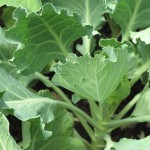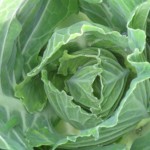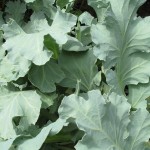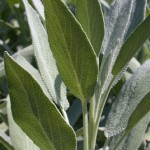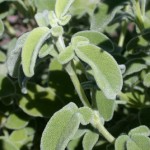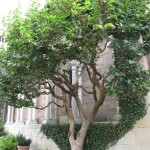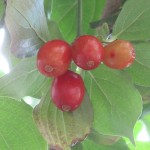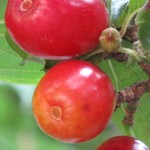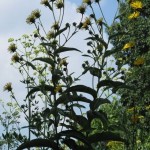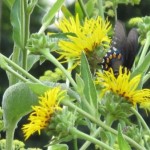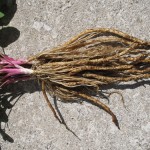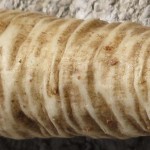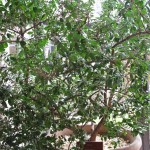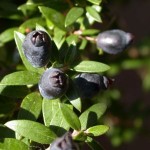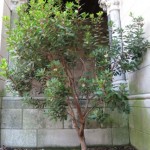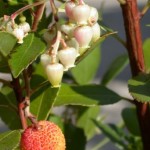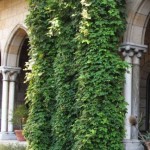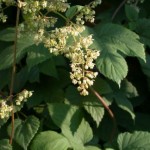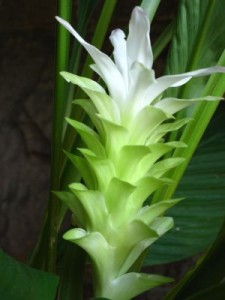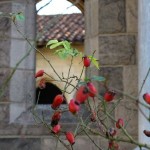
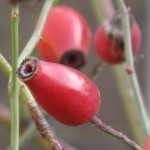
Above, from left: The ripe fruits of the white rose tree in Bonnefont garden are held on their stems late into the fall, and provide food for birds and wildlife; the fleshy red fruits of the rose are known as “hips” and contain seeds that were used medicinally in the Middle Ages.
Apples, roses, and hawthorns are all members of a single botanical family, the Rosaceae. The fruits of the hawthorn are known as haws. The fruits of the rose are known as hips, a word of Germanic origin that appears in the glossary compiled by the Anglo-Saxon grammarian Aelfric in the ninth century.?? (The Romans had designated the rose hip as malum roseum, or “rose apple”.)
While all roses bear hips, it was the fruit of wild roses such as the briar rose or eglantine (R. rubiginosa) and the dog rose (R. canina) that seem to have been used for food and medicine. The cookbook of Apicius, compiled in the fourth or early fifth century A.D., includes rose hips in several recipes, but in both ancient and medieval cuisine rose petals are used more often than the fruits. Wild roses seem to have been a famine food gathered in case of need rather than a delicacy. In the fourteenth-century Middle English translation of the Romance of William of Palerne, two lovers, William and Melior, flee to the woods disguised in bearskins, where William is given advice by his cousin???who has been transformed into a werewolf???as to what foods they may sustain themselves on, in addition to their love. It is suggested that they forage for wild plums, blackberries, hips, haws, acorns, and hazelnuts (”haws, hepus, & hakernes & hasel-notes”):

(For acorns as famine food, see last week’s post, “Pigs and Pannage“.)
William Turner, in his New Herbal of 1565, warns that those who make tarts out of hips should take heed to remove all the “down” from the fruit. These little hairs inside the hips are quite irritating to the skin. (I once made hedgerow jelly from hips, haws, and sloes, while in England, and found the process of removing the fibers from all those little hips pretty unpleasant, as well as tedious.) Dioscorides also recommended that this wooly matter be removed before the fruits were dried as a medicament to “stop the belly.”?? Albertus Magnus specified the seeds contained in the hips as a remedy for diarrhea in infants.
Rose petals and oil of roses are more frequently recommended in medieval herbals than the fruits. Although garden roses were characterized as cold in the humoral theory of the Middle Ages, wild roses were classified as hot. Hildegard of Bingen says that the hips are very hot. As such, they would be considered efficacious in a complaint of?? “a cold cause,” such as catarrh.) Hildegard recommends rose hips as a cure in Book LII of the Physica:
One who has pain in his lungs should crush rose hips with their leaves. Then he should add raw honey and cook these together. He should frequently remove the froth, then strain it through a cloth and make spiced wine. He should drink this often, and it will carry off the rotten matter from his lungs, purging and healing him.
Despite the flower???s ubiquity in medieval art, rose hips are rarely depicted in paintings or illuminations. However, a leafy stem of rose hips does appear in an early sixteenth-century book of hours commissioned by Anne of Brittany and painted by Jean Bourdichon. The painter shows a single “robin???s pincushion” or rose gall, formed by a parasitic wasp. (For the illumination, see the British Library Images Online.)
The gall, which is especially common on the wild field rose (R. arvensis) and the dog rose, is created when the wasp deposits its eggs in autumn. The larvae overwinter in the plant tissue, which provides both food and shelter until they hatch out in spring. This rose gall, known as a “bedeguar,” was powdered and used to treat internal ailments.
???Deirdre Larkin
Sources:
Fisher, Celia. The Medieval Flower Book. London: The British Library, 2007.
Throop, Priscilla, transl. Hildegard von Bingen’s Physica: The Complete English Translation of Her Classic Work on Health and Healing. Rochester, VT: Healing Arts Press, 1998.
Touw, Mia. ???Roses in the Middle Ages,??? Economic Botany, Vol. 36, No. 1 (Jan.???Mar., 1982).
